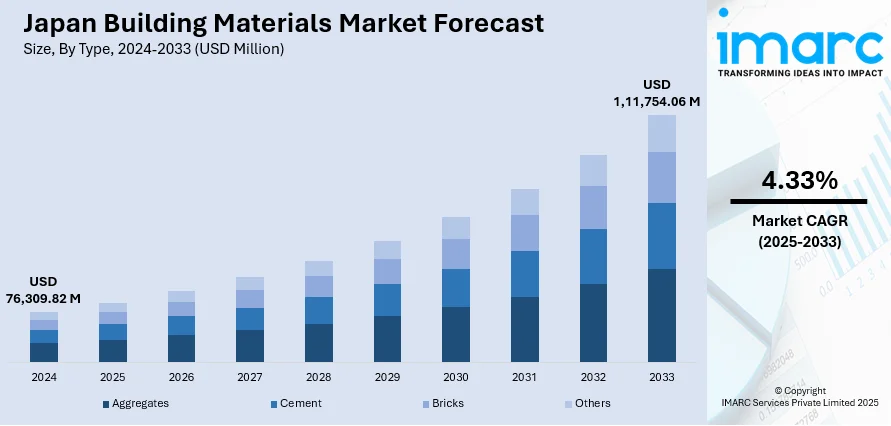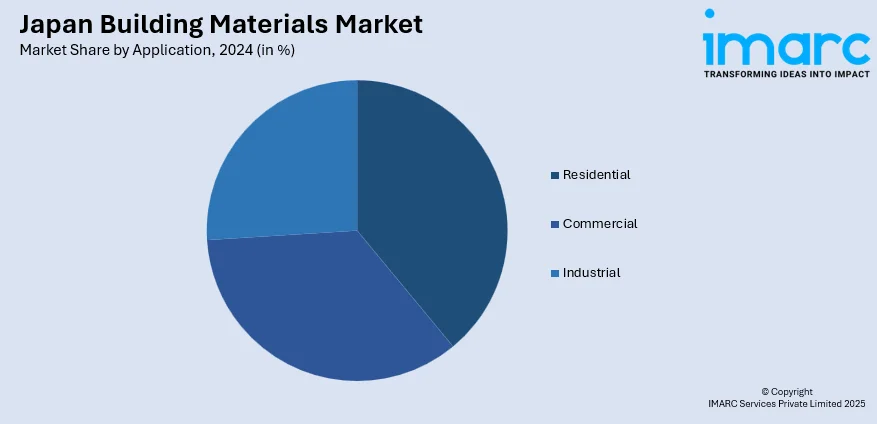
Japan Building Materials Market Size, Share, Trends and Forecast by Type, Application, and Region, 2025-2033
Japan Building Materials Market Overview:
The Japan building materials market size reached USD 76,309.82 Million in 2024. Looking forward, IMARC Group expects the market to reach USD 1,11,754.06 Million by 2033, exhibiting a growth rate (CAGR) of 4.33% during 2025-2033. At present, Japan's commitment to earthquake-resistant and energy-efficient buildings is influencing the market positively, as construction activities necessitate specialized materials, including high-performance insulation. Besides this, the rising development of tourism infrastructure owing to the increasing number of travelers is contributing to the expansion of the Japan building materials market share.
|
Report Attribute
|
Key Statistics
|
|---|---|
|
Base Year
|
2024 |
|
Forecast Years
|
2025-2033
|
|
Historical Years
|
2019-2024
|
| Market Size in 2024 | USD 76,309.82 Million |
| Market Forecast in 2033 | USD 1,11,754.06 Million |
| Market Growth Rate 2025-2033 | 4.33% |
Japan Building Materials Market Trends:
Rising construction activities
The market is being positively impacted by an increase in construction activity. There are more building projects nationwide as a result of the increased demand for new residential, commercial, and industrial structures brought on by the acceleration of urbanization. The demand for building materials is also being driven by the government's continuous attempts to invest in the development of infrastructure, such as public facilities, transit networks, and smart city initiatives. Japanese steel producer JFE Steel received government support in December 2024 for its plan to build an electric arc furnace (EAF) at the West Japan Works site in Kurashiki. Since construction projects call for specialist materials like seismic-resilient components and high-performance insulation, Japan's dedication to energy-efficient and earthquake-resistant buildings is also having a favorable impact on the industry. Furthermore, the growth of the real estate sector, including both residential and commercial properties, is creating the need for quality building materials. The trend of renovation and refurbishment of existing buildings is promoting the use of modern materials for upgrades. As construction activities are increasing, manufacturers of building materials are innovating to meet specific demands, focusing on sustainability, durability, and eco-friendly materials. With the broadening of residential areas, office spaces, and infrastructure projects, the materials market continues to grow in the country.

Increasing development of tourism infrastructure
The rising development of tourism infrastructure is fueling the Japan building materials market growth. As Japan continues to gain popularity as an attractive travel destination, the government and private sectors are investing heavily in expanding tourism infrastructure to accommodate increasing visitor numbers. The Japan National Tourism Organization (JNTO) estimated that the number of international visitors to Japan in February 2025 was set to reach 3,258,100, reflecting a 16.9% growth over 2024. The development includes the construction of new hotels, the broadening of airports, the renovation of historical sites, and the establishment of recreational facilities. These projects require a wide assortment of building materials, such as cement, steel, glass, and specialized finishes, to meet the needs of modern, sustainable, and high-quality structures. Additionally, the shift towards developing eco-friendly and energy-efficient buildings in the tourism sector is catalyzing the demand for innovative building materials like sustainable insulation, renewable energy solutions, and environment friendly construction items.
Japan Building Materials Market Segmentation:
IMARC Group provides an analysis of the key trends in each segment of the market, along with forecasts at the country and regional levels for 2025-2033. Our report has categorized the market based on type and application.
Type Insights:
- Aggregates
- Cement
- Bricks
- Others
The report has provided a detailed breakup and analysis of the market based on the type. This includes aggregates, cement, bricks, and others.
Application Insights:

- Residential
- Commercial
- Industrial
A detailed breakup and analysis of the market based on the application have also been provided in the report. This includes residential, commercial, and industrial.
Regional Insights:
- Kanto Region
- Kansai/Kinki Region
- Central/Chubu Region
- Kyushu-Okinawa Region
- Tohoku Region
- Chugoku Region
- Hokkaido Region
- Shikoku Region
The report has also provided a comprehensive analysis of all the major regional markets, which include Kanto Region, Kansai/Kinki Region, Central/Chubu Region, Kyushu-Okinawa Region, Tohoku Region, Chugoku Region, Hokkaido Region, and Shikoku Region.
Competitive Landscape:
The market research report has also provided a comprehensive analysis of the competitive landscape. Competitive analysis such as market structure, key player positioning, top winning strategies, competitive dashboard, and company evaluation quadrant has been covered in the report. Also, detailed profiles of all major companies have been provided.
Japan Building Materials Market News:
- In February 2025, Sumitomo Corporation, based in Tokyo, teamed up with Arelac, Inc. to build a commercially viable low-carbon cement facility in Japan. The latter created a technology that captured CO2 released during cement manufacturing and converted it back into calcium oxide, yielding a granular type of calcium carbonate that differed from its state before thermal decomposition. This technology allowed a 60% decrease in CO2 emissions linked to cement production by recarbonating CO2 and other substances, facilitating the creation of low-carbon cement.
- In October 2024, a group of researchers from the University of Tokyo and Hokkaido University in Japan discovered a method to create concrete that would generate almost no carbon dioxide (CO2) during its manufacturing. The material took in more CO2 than it emitted. The team strived to enhance production efficiency without compromising the quality of the material.
Japan Building Materials Market Report Coverage:
| Report Features | Details |
|---|---|
| Base Year of the Analysis | 2024 |
| Historical Period | 2019-2024 |
| Forecast Period | 2025-2033 |
| Units | Million USD |
| Scope of the Report | Exploration of Historical Trends and Market Outlook, Industry Catalysts and Challenges, Segment-Wise Historical and Future Market Assessment:
|
| Types Covered | Aggregates, Cement, Bricks, Others |
| Applications Covered | Residential, Commercial, Industrial |
| Regions Covered | Kanto Region, Kansai/Kinki Region, Central/Chubu Region, Kyushu-Okinawa Region, Tohoku Region, Chugoku Region, Hokkaido Region, Shikoku Region |
| Customization Scope | 10% Free Customization |
| Post-Sale Analyst Support | 10-12 Weeks |
| Delivery Format | PDF and Excel through Email (We can also provide the editable version of the report in PPT/Word format on special request) |
Key Questions Answered in This Report:
- How has the Japan building materials market performed so far and how will it perform in the coming years?
- What is the breakup of the Japan building materials market on the basis of type?
- What is the breakup of the Japan building materials market on the basis of application?
- What is the breakup of the Japan building materials market on the basis of region?
- What are the various stages in the value chain of the Japan building materials market?
- What are the key driving factors and challenges in the Japan building materials market?
- What is the structure of the Japan building materials market and who are the key players?
- What is the degree of competition in the Japan building materials market?
Key Benefits for Stakeholders:
- IMARC’s industry report offers a comprehensive quantitative analysis of various market segments, historical and current market trends, market forecasts, and dynamics of the Japan building materials market from 2019-2033.
- The research report provides the latest information on the market drivers, challenges, and opportunities in the Japan building materials market.
- Porter's five forces analysis assist stakeholders in assessing the impact of new entrants, competitive rivalry, supplier power, buyer power, and the threat of substitution. It helps stakeholders to analyze the level of competition within the Japan building materials industry and its attractiveness.
- Competitive landscape allows stakeholders to understand their competitive environment and provides an insight into the current positions of key players in the market.
Need more help?
- Speak to our experienced analysts for insights on the current market scenarios.
- Include additional segments and countries to customize the report as per your requirement.
- Gain an unparalleled competitive advantage in your domain by understanding how to utilize the report and positively impacting your operations and revenue.
- For further assistance, please connect with our analysts.
 Request Customization
Request Customization
 Speak to an Analyst
Speak to an Analyst
 Request Brochure
Request Brochure
 Inquire Before Buying
Inquire Before Buying




.webp)




.webp)












